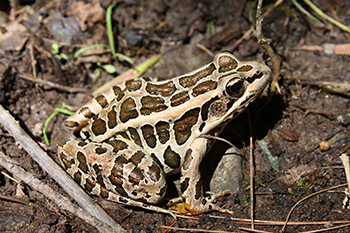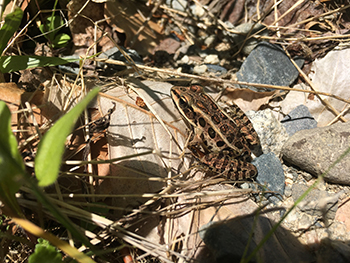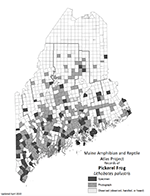Home → Fish & Wildlife → Wildlife → Species Information → Reptiles & Amphibians → Pickerel Frog
Pickerel Frog
Lithobates palustris
On this page:

Photo: Trevor Persons
Distinguishing Characteristics
- Medium-sized, approximately 2 to 3 inches in length
- Bronze-brown above with two parallel rows of large, squarish dark spots on back between prominent ridges (dorsolateral folds) along sides of back from behind eye to near groin
- Bright yellow-orange coloration on the underside of the hind legs
- Commonly confused with northern leopard frog
- Breeding call is an even, low-pitched snore, with individual notes hard to discern
Status and Distribution in Maine
- Common and secure
- Statewide, but absent from parts of northern Maine
Habitat

Photo: Phillip deMaynadier
- Wet fields and meadows; the shores of lakes, ponds, and streams; wet woods; and sphagnum bogs
- Often found in damp grass of lawns in mid-summer
Diet
- Eats a wide variety of terrestrial and aquatic invertebrates including beetles, caterpillars, spiders, pillbugs, snails, crayfish, and isopods
Seasonal Changes
- Hibernates in mud at bottom of ponds
Natural History Notes
- Emerge from hibernation in late April or early May and breed when air temperatures climb above 50 �F
- Yellow undersides presumably signal to potential predators that the species possesses mildly toxic (distasteful) skin secretions
Share Your Sighting
There is much still to learn about the distribution and ecology of Maine’s herpetofauna, and we encourage members of the public to share their photo-documented observations as part of the Maine Amphibian & Reptile Atlas Project (MARAP).
To see if a township still needs documentation of a species, consult this distribution map (PDF). If a township lacks a photo or specimen record, we want your observation!
There are two ways to share your observations:
Submit your reptile or amphibian observation online
No service? No problem. Click here to download the survey to your device while connected, then take offline to collect observations from anywhere. Tip: The survey works best on Google Chrome and Safari.
Or upload sightings to the iNaturalist citizen science project through their website at iNaturalist.org or mobile app.
- When submitting an observation through iNaturalist add a description of the location (and other noteworthy information) to the “notes” field. This serves as a check on the locations automatically generated by smartphone cameras, which may be imprecise if cell service or GPS coverage is weak.
Thank you for doing your part to help conserve Maine’s reptiles and amphibians.
